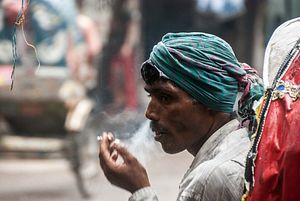The devastating effects of climate change — floods, salinization of land, destructive super cyclones, and reduced agricultural yields — have displaced millions of people from rural Bangladesh. Hundreds of thousands of people each year flee to Dhaka, one of the most densely populated cities on earth, to seek work and shelter. Dhaka’s slums are overcrowded and expensive, and many new arrivals are forced to make their homes wherever they can find space: in alleys, on footpaths, under bridges, or by the river port; under plastic sheeting and blue tarpaulins; in parks, graveyards, bus stations, and train stations; behind stadiums and religious centers; next to the High Court of Bangladesh; in between luxury high-rise condominium buildings named for exotic flowers.
Displaced primarily from Bangladesh’s southern and eastern regions, these are climate change refugees, called the “pavement dwellers” of Dhaka— soon to be the largest megacity in the world. As the effects of climate change increase, almost half a million people flee to this expanding city every year. Currently, 7 million people, representing 40 percent of Dhaka’s population, live in the slums, riverbanks, parks, and trains stations of the city. The International Organization for Migration (IOM) and UN Habitat have estimated that 70 percent of these 7 million residents have arrived as a consequence of climate change.
As one young government official explained: “They come to Dhaka because they cannot live any longer where they are from. They come because Dhaka is the Change Luck City.”
Many of these citizens lack essential access to water, sanitation, education, and decent housing. Most are effectively stateless, as regional rights of origin often do not transfer to their new city. They supply the second largest garment industry in the world, and the privately owned $2 billion-a-year plastics recycling industry, with workers, and they and their families live in every available public or abandoned space in Dhaka. A small number of NGOs attempt to meet the pavement dwellers’ basic requirements for sanitation, education, and employment training; but with so many people arriving in the city each year, it is almost impossible to adequately address these needs by NGO support alone. There is no official national policy to address the lack of housing in Dhaka. State leaders have recently requested $4 billion from international aid agencies to address climate change mitigation, adaptation, and development, but it is unclear what percentage, if any, of the funds received might be used for housing and services for the pavement dwellers of Dhaka.
Nellie Le Beau and Hugh Tuckfield live and work in South Asia, Europe, the Middle East, the Americas, and the Asia Pacific region, photographing humanitarian situations including climate change, refugees, migration, and other human rights issues. You can view more of their work on their website.















































